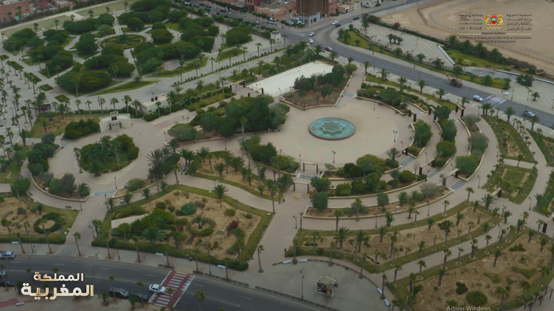
LAAYOUN - Panoramic view
Despite the rising popularity of modern clothing relative to traditional dress in most countries around the world, the traditional clothing of Morocco’s Sahara region has maintained its prominence and importance.
Sahrawi traditional clothing, including the "Daraa" worn by men and women’s "Mlahfa" - special items which are passed down from one generation to the next, is considered a key part of the Sahrawis' identity, and one of the most important aspects of their Hassaniya culture, also known as "Al-Baydan culture."
Just as amazigh, Fassi, Jabli, and Oujdi women each wear unique outfits, Saharawi women wear a "Mlahfa" on a daily basis, whatever the occasion. Women of all ages and socioeconomic groups in the Sahara consider the "Mlahfa" as a sign of femininity and beauty.
The "Mlahfa" is a dress made out of a single piece of fabric; it usually is four meters long and one and a half meters wide. Available in a range of fabrics and colors, Mlahfa prices vary according to quality.
The most distinguishing feature of this feminine Sahrawi dress is its simplicity. It is a single piece with two simple knots at the top connecting to two loops called "khilalin," which allow the wearer to free her head and hands. Tied at the shoulders, it is wrapped around the waist to cover the entire body except for the hands and face.
Aside from being a fashionable item, the "Mlahfa" is designed to repel the strong Sahara sun's rays and protect the skin from sunburn.
There are several varieties of "Mlahfas." Some are worn on a daily basis, while others are reserved for special events such as weddings and holidays. Some come in a single block color, while others are adorned with detailed embroidery and special designs.
"Al-Shekka," "Kaniba," "Kaz," "Counter," "Chiffon," and "Sample" are all varieties of "Mlahfas," with names indicating the type of fabric, such as pure cotton, or a specific design or color variant.
As it was given a slightly different name in each country, the "Mlahfa" was worn in the past by all women in most African region for special events, holidays, and weddings. Its design is influenced by cultures and clothing from a range of countries.
Demand for "Mlahfa" among Sahrawi women remains high, despite the extortionate prices of some pieces - "Mlahfa" prices can range from 50 Moroccan dirhams for some "Mlahfa" such as the "Kaz," to 20,000 Moroccan dirhams for a pure silk piece.
Sahrawi men also have their own dress, known as the “Daraa”. A ten-meter-long soft garment, the "Daraa" dates back hundreds of years to the early days of trans-Saharan commerce between Sub-Saharan and North Africa in the 7th and 8th centuries.
The Sahrawi "Daraa" is a loose men’s dress, bearing some colorful decorations, with two wide openings on each side. It comes either in blue or white. The Sahrawi men wear "Daraa" on a day-to-day basis as well as on holidays and special occasions. It is usually worn with a shirt and loose “Arab” pants.
This traditional Sahrawi garment goes through four steps before it is ready. First, each section is laid out separately, before the designer traces the decorations for an embroiderer then to overlay. Finally, it is sewed together and assembled.
There are several types of Sahrawi "Daraa" that can be worn depending on the occasion. The "Belman Daraa" is rare and expensive, and is worn only at weddings and on special occasions. There is also the "Bakha," a two-sided "Daraa," which has two distinct colors on each side. The "Shikka" is another variety, a thinner version worn for daily activities in hot weather.
The price of the Sahrawi "Daraa," along with the shirt and loose "Arab" pants, ranges between 700 and 3,000 Moroccan dirhams. Demand is often particularly high during holidays and religious occasions.

